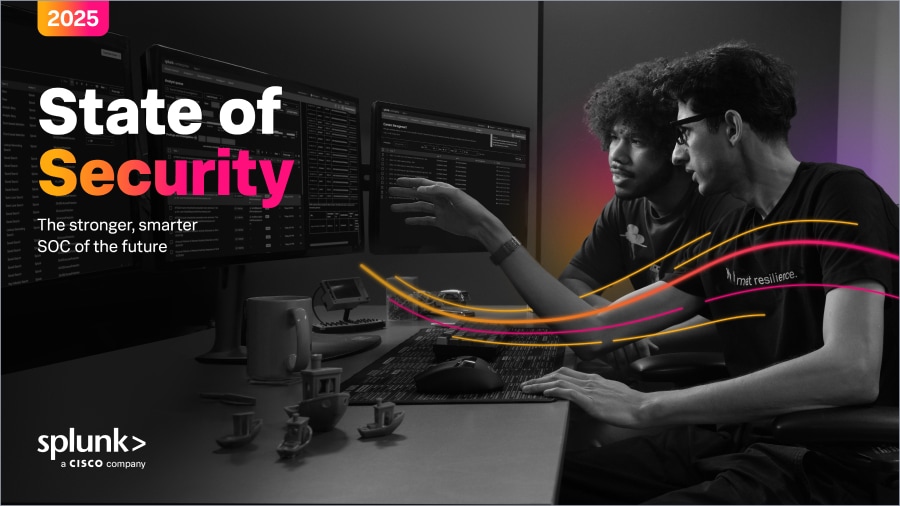Mission Control for Modern Risk

Financial institutions face a harsh reality. As cyberattacks have become more sophisticated and move with greater velocity, a single incident can ripple across IT systems, payment networks, and customer accounts long before the organization can respond.
The problem? Most security, fraud, IT operations, and risk teams still operate in silos. Each team monitors their own consoles, works from its own data, and follows its own playbooks. The overall organizational impact is alert overload, delayed response, and threats left uncontained. In fact, in Splunk’s 2025 State of Security report, 59% of respondents cited “too many alerts” as a top source of SOC inefficiency.
This is where fusion centers come into play. A cyber fusion center is an advanced security operations model designed to unify threat detection, investigation, and response across multiple teams, data sources, and disciplines. It functions as mission control, pulling signals from across the organization, like endpoint logs, cloud identity events, payment messages, OT sensor alerts, and external threats, feeding into a single operational view.
The payoff is speed and context. Where it used to take organizations hours to coordinate incident response, they can now contain the damage in minutes. Incidents that once took an organization hours to coordinate across teams can now be contained in minutes, providing the resolution that executives need and regulators demand.

Resilience starts with strategy
Why fusion center adoption stalls
So, if fusion centers sound like the greatest thing since sliced bread, why aren’t they everywhere?
In the past, technology was the barrier. Today, it isn’t. Modern SIEM and SOAR platforms can ingest virtually any telemetry — endpoints, cloud logs, payment data — normalize it, automate first‑pass containment, and produce a clean, auditable timeline. Storage is now cheap enough that selective logging is no longer an excuse. Five years ago, this wasn’t possible. Now, the real obstacles are process, culture, and compliance.
- Process maturity is in short supply.
Fusion centers live or die by disciplined, repeatable playbooks. Picture this: A high‑value wire looks suspicious. The system freezes the transfer, collects all related logs, and opens one case for fraud analysts. Confirmed fraud? Anti-money laundering (AML) and security get the alert, a suspicious activity report (SAR) draft is generated, and the workflow loops its lessons back into detection rules. Skip this rigor, and your “fusion center” is just another pretty dashboard. - Then there’s culture.
Security, fraud, AML, compliance, and threat intel teams grew up independent and isolated — different missions, tools, metrics, and even regulators. De facto departmental boundaries mean they don’t naturally share information. A fusion center forces them to. Executive backing and KPIs that span all teams — and tie directly to revenue protection and resilience — are non‑negotiable. - And finally, compliance adds further friction.
Effective compliance monitoring depends on protecting sensitive data by correlating information through selectors rather than raw records. A selector — such as a transaction ID, user ID, or other unique identifier — acts as an anchor that links related events across distributed datasets without exposing personal details. By relying on these anchors, fusion centers can identify patterns, connect fraud or security signals to investigations, and maintain strict privacy.
In short, tech will get you started, but process, culture, and compliance determine whether a fusion center is nothing more than a pipedream.
How fusion centers have evolved
The fusion center model originally began in government after 9/11 when investigators discovered that vital plot indicators were hidden away in separate agencies such as the FBI, local police, and intelligence services, each with its own data store. Sound familiar?
Fast forward, financial services came next. With torrential fraud attempts and mounting regulatory pressure, banks have little choice but to unite their cyber, fraud, AML, and risk teams into a united front. And then the energy sector followed, and so forth. Adopting a fusion center model is essentially mandated by the business and regulatory environment.
The tighter the link between digital operations and revenue, or the heavier the regulatory burden, the stronger the pull toward a fusion center model.
But five years ago, “fusion” often meant expanding the existing SOC, bringing threat intel, incident response, and fraud analysis into the same war room and hoping proximity would close the gaps. That still meant three separate consoles sitting side-by-side-by-side, with teams still emailing screenshots and manually reconciling logs. Real coordination remained elusive.
Today’s fusion-center model is quite different. Built on an observability foundation with a clear security mandate, all telemetry flows into a single analytics platform with consistent schemas and timestamps. On that shared data layer, SOAR playbooks trigger instantly to quarantine hosts, freeze suspicious transfers, or draft SARs without waiting for manual handoffs.
However, the shift goes beyond automation as AI models are being actively tested and encouraged so analysts can work with context instead of raw logs. Each incident then feeds back into detection rules and playbooks in real time. As new observability sources such as supplier-portal data, insider-risk signals, and geopolitical indicators are added, fusion centers continue to evolve, going beyond containing threats to keeping an eye on service health and business continuity.
Dashboards now stop counting tickets and start answering questions like, How much risk did we remove? How resilient are our critical services?
What to keep in mind when building your fusion center
As the saying goes, “Vision without execution is hallucination.” This logic applies profoundly to organizations that see their fusion center implementations derailed by trying to build all of the components at once. Attempting to deploy every feed, tool, playbook, report, and stakeholder simultaneously creates an unmanageable scope.
Breaking the rollout into a focused pilot is critical. I advise clients to design small, test small, and then expand.
The most important thing to do to get started is selecting one high‑value telemetry stream, say a payment rail in banking or a critical OT alarm, and proving measurable gains on business KPIs within a quarter. Bring the risk and compliance teams into design sessions early.
If your compliance record isn’t captured automatically, you may risk delays and incomplete documentation. Regulators may ask for the exact timestamp of a wire freeze, who approved it, which logs were consulted, and how AML was notified. Instead, bake compliance into every playbook step. Each SOAR action should produce a timestamp, actor ID, and attached logs in a single case file.
A proper fusion center provides metrics that tie directly to core business goals. That’s what makes it so valuable.
By measuring the total value of fraudulent transactions it blocks, you see real dollars protected. Tracking payment rail uptime demonstrates service reliability and preserves customer trust. Shorter detection and response times reduce the window threat actors have. Automating compliance reporting ensures you meet legal timelines. And by collecting evidence automatically, analyst time is freed up for worthier pursuits. As these metrics improve, the fusion center’s impact on the bottom line becomes clear.
The core data platform at the heart of a fusion center must unify telemetry, including cloud identity, OT, fraud, and third parties. SOAR playbooks need to halt suspicious transfers in seconds. AI augmentation can handle anomaly detection and enrichment before staff open a ticket. Built-in compliance reports convert technical events into regulator-friendly summaries. When these pieces run on the same unified data platform, integration friction disappears, and leaders can focus on process and risk.
Mastercard’s new European Cyber Resilience Centre shows the model in action. The facility’s fusion center unites fraud, cybersecurity, and physical security teams in a single environment, what the company calls “the heart of incident response,” so analysts work from a unified picture and can coordinate containment in real time. Raiffeisen Bank International went a step further. By replacing roughly 750 manual steps across nearly 100 standard procedures with 60 automated playbooks, the bank cut response time to a single analyst approval and freed staff to focus on investigation rather than assembly.
What’s next?
In the future, fusion centers will pull in new data sources, going beyond traditional IT and security. They’ll integrate supply chain telemetry, insider risk analytics, GRC feeds, and even external signals like market data, geopolitical events, and weather patterns.
Business disruptions rarely stay in their lanes, so identifying fiber optic outages or sudden storms that can affect operations long before an alert fires off is extremely valuable. And by fusing internal and external data, executives gain a strategic, real-time view of business resilience — allowing faster, better-informed decisions.
Automation will advance to include lightweight AI agents, which are small language models trained on your own incident data. These will be able to draft incident summaries, highlight findings, and suggest the next containment steps. As this capability matures, KPIs will be able to report in business terms, for example, to answer how much risk or fraud the organization actually reduced.
Traditional teams and data silos remain the obstacle, yet postponing change keeps risk scattered and amorphous. Instead, plan your fusion center thoroughly, pilot a single, high-value use case — for example, a real-time payments rail — and expand from that success. Let the numbers show what happens when risk is no longer hidden. Waiting any longer simply turns today’s blind spots into tomorrow’s incident report.
Get more executive perspectives straight to your inbox with the Perspectives newsletter.
Related Articles
About Splunk
The world’s leading organizations rely on Splunk, a Cisco company, to continuously strengthen digital resilience with our unified security and observability platform, powered by industry-leading AI.
Our customers trust Splunk’s award-winning security and observability solutions to secure and improve the reliability of their complex digital environments, at any scale.


